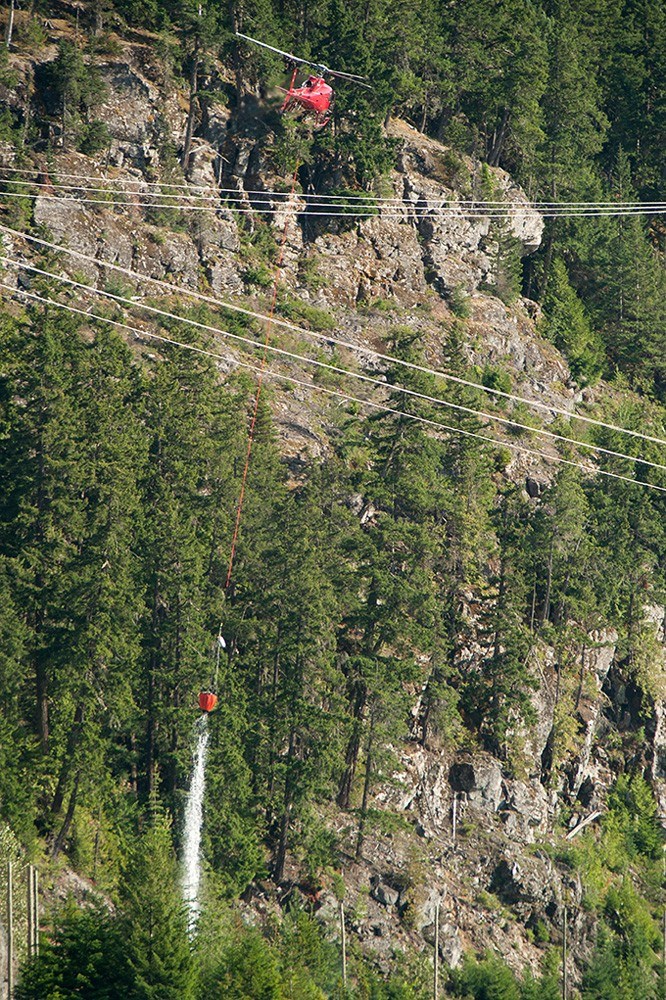Whistler Fire Rescue Services responded to a fire along the shores of Green Lake late in the afternoon, July 23.
"The call came in about 5:30 p.m. this afternoon," explained acting fire chief Chris Nelson.
"The duty crew responded with a rescue boat and Blackcomb Helicopters responded as well (by water bombing)."
While the cause of the blaze has not yet fully been determined, Nelson said it could have been sparked by crew activity along the CN rail line. He will be following up with CN.
Sparks can cause fire up to 24 hours from when they are generated in the type of tinder dry conditions Whistler and other parts of the province are experiencing at the moment.
"That's what we think has happened," said Nelson.
"The fire was out by about quarter past six, but Blackcomb Helicopters did bucket it.
"Don't forget that we are in 'Extreme' fire conditions right now, the forest is tinder dry."
Nelson is reminding people not to have any type of fire.
"Forty per cent of fires are human caused," he cautioned.
"The good thing is we all know this in Whistler and we are super vigilant right now. There is a happy ending here as the fire is out."
Whistler considers wildfire one of its greatest threats and this year will spend $1,462,000-$618,000 from municipal reserves and $844,000 from provincial grants-on wildfire prevention.
This year, the RMOW is doing fuel-thinning work near Big Timber/Kadenwood, Alpine Meadows and the Whistler Cemetery, as well as along Callaghan Forest Service Road in partnership with the Cheakamus Community Forest.
Fuel thinning along Cheakamus Lake Road will begin this fall.
The municipality is developing a detailed plan for the next three years, including fuel-thinning prescriptions for three units near the Rainbow area and other key high priority areas, as well as a new Wildfire Development Permit area to be included in the updated Official Community Plan.
The 2018 budget also covers the Sea to Sky Multimodal Evacuation Plan, the FireSmart crew and three new response trucks for the Whistler Fire Rescue Service.
In 2017, the RMOW did FireSmart work on 17 critical infrastructure sites, including water and sewer pump stations and around Fire Hall 2. But the municipality still has a list of 51 critical sites to protect, some of which involve Crown land and moving through the provincial referral system.
A new early-detection system was installed in June (and expected to be in full operation by the end of July), consisting of two cameras-one on Whistler Mountain and one at the Whistler Transfer Station-able to detect heat and smoke signatures in the valley.
The cameras cover off about 70 per cent of the valley, and are able to notify the Whistler Fire Rescue Service at the first sign of a fire.
There are currently eight wildfires of note burning across B.C., with the worst centred in the Okanagan. Wildfire conditions were calmer across British Columbia on the weekend, but there is concern that climbing temperatures and gusty winds could impact the wildfires worsening the conditions.
Environment Canada is calling for winds gusting to 50 kilometres per hour over the Kelowna area and lightning is also forecast for several parts of the province, including the Okanagan Valley.
So far this year (April 2018 to March 2019), there have been 648 fires, with 50,802 hectares burned. On average, 60 per cent are caused by lightning and 40 per cent by people.
To report a wildfire, unattended campfire or open burning violation, call 1 800 663-5555 toll-free or *5555 on a cellphone. For the latest information on current wildfire activity, burning restrictions, road closures and air quality advisories, visit:bcwildfire.ca
-with files from Braden Dupuis




